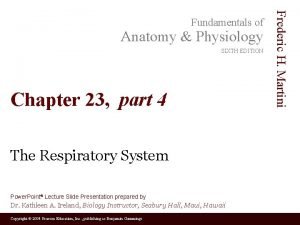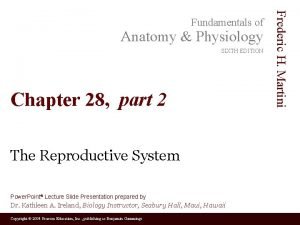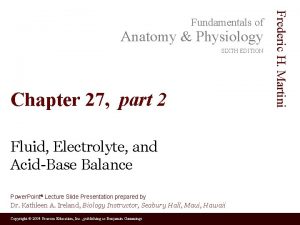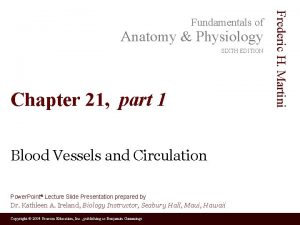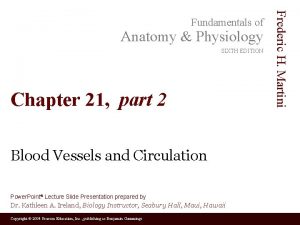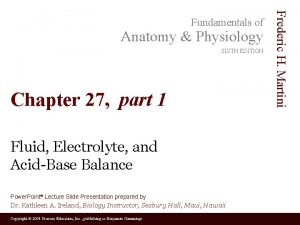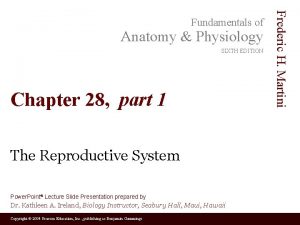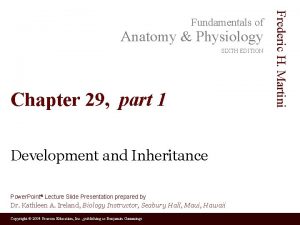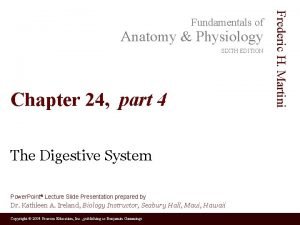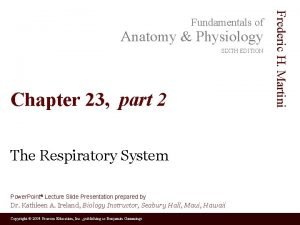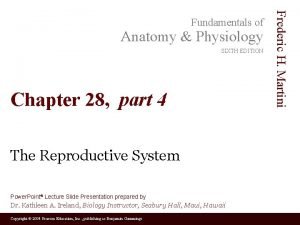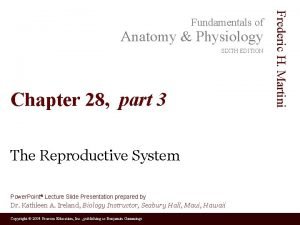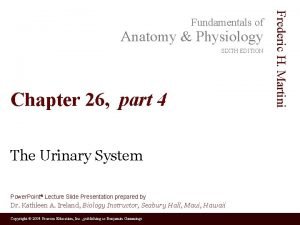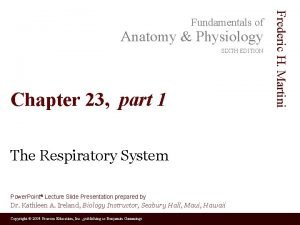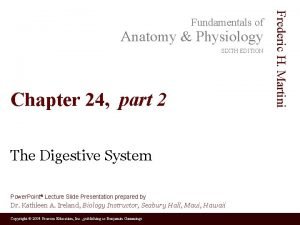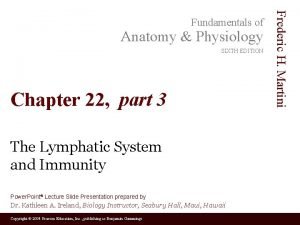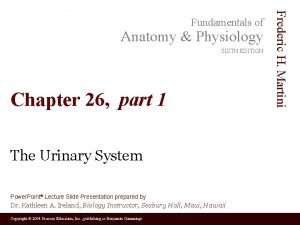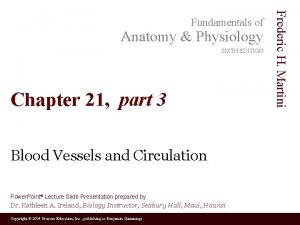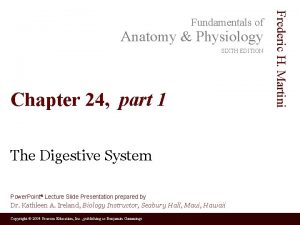Anatomy Physiology SIXTH EDITION Chapter 20 part 4




















- Slides: 20

Anatomy & Physiology SIXTH EDITION Chapter 20, part 4 The Heart Power. Point® Lecture Slide Presentation prepared by Dr. Kathleen A. Ireland, Biology Instructor, Seabury Hall, Maui, Hawaii Copyright © 2004 Pearson Education, Inc. , publishing as Benjamin Cummings Frederic H. Martini Fundamentals of

Factors Affecting Heart Rate • Autonomic innervation • Cardiac reflexes • Tone • SA node • Hormones • Epinephrine (E), norepinephrine(NE), and thyroid hormone (T 3) • Venous return Copyright © 2004 Pearson Education, Inc. , publishing as Benjamin Cummings

Figure 20. 20 Factors Affecting Cardiac Output Copyright © 2004 Pearson Education, Inc. , publishing as Benjamin Cummings Figure 20. 20

Medulla Oblongata centers affect autonomic innervation • Cardioacceleratory center activates sympathetic neurons • Cardioinhibitory center controls parasympathetic neurons • Receives input from higher centers, monitoring blood pressure and dissolved gas concentrations Copyright © 2004 Pearson Education, Inc. , publishing as Benjamin Cummings

Figure 20. 21 Autonomic Innervation of the Heart Copyright © 2004 Pearson Education, Inc. , publishing as Benjamin Cummings Figure 20. 21

Figure 20. 21 Autonomic Innervation of the Heart Copyright © 2004 Pearson Education, Inc. , publishing as Benjamin Cummings Figure 20. 21

Basic heart rate established by pacemaker cells • SA node establishes baseline • Modified by ANS • Atrial reflex Copyright © 2004 Pearson Education, Inc. , publishing as Benjamin Cummings

Figure 20. 22 Pacemaker Function Copyright © 2004 Pearson Education, Inc. , publishing as Benjamin Cummings Figure 20. 22

Figure 20. 22 Pacemaker Function Copyright © 2004 Pearson Education, Inc. , publishing as Benjamin Cummings Figure 20. 22

Factors Affecting stoke volume • EDV • Frank-Starling principle • ESV • Preload • Contractility • Afterload Copyright © 2004 Pearson Education, Inc. , publishing as Benjamin Cummings

Figure 20. 23 Factors Affecting Stroke Volume Copyright © 2004 Pearson Education, Inc. , publishing as Benjamin Cummings Figure 20. 23

Figure 20. 23 Factors Affecting Stroke Volume Copyright © 2004 Pearson Education, Inc. , publishing as Benjamin Cummings Figure 20. 23

Autonomic Activity • Sympathetic stimulation • Positive inotropic effect • Releases NE • Parasympathetic stimulation • Negative inotropic effect • Releases ACh Copyright © 2004 Pearson Education, Inc. , publishing as Benjamin Cummings

Exercise and Cardiac Output • Heavy exercise can increase output by 300 -500 percent • Trained athletes may increase cardiac output by 700 percent • Cardiac reserve • The difference between resting and maximal cardiac output PLAY Animation: Cardiac cycle Copyright © 2004 Pearson Education, Inc. , publishing as Benjamin Cummings

Summary: Regulation of Heart Rate and Stroke Volume • Sympathetic stimulation increases heart rate • Parasympathetic stimulation decreases heart rate • Circulating hormones, specifically E, NE, and T 3, accelerate heart rate • Increased venous return increases heart rate • EDV is determined by available filling time and rate of venous return • ESV is determined by preload, degree of contractility, and afterload Copyright © 2004 Pearson Education, Inc. , publishing as Benjamin Cummings

Figure 20. 24 A Summary of the Factors Affecting Cardiac Output Copyright © 2004 Pearson Education, Inc. , publishing as Benjamin Cummings Figure 20. 24

SECTION 20 -5 The Heart and the Cardiovascular System Copyright © 2004 Pearson Education, Inc. , publishing as Benjamin Cummings

The heart is part of the cardiovascular system • The goal of the cardiovascular system is to maintain adequate blood flow to all body tissues • The heart works in conjunction with cardiovascular centers and peripheral blood vessels to achieve this goal Copyright © 2004 Pearson Education, Inc. , publishing as Benjamin Cummings

You should now be familiar with: • The organization of the cardiovascular system. • The location and general features of the heart, including the pericardium. • The differences between nodal cells and conducting cells as well as the components and functions of the conducting system of the heart. • The electrical events associated with a normal electrocardiogram. Copyright © 2004 Pearson Education, Inc. , publishing as Benjamin Cummings

You should now be familiar with: • The events of the cardiac cycle including atrial and ventricular systole and diastole, and the heart sounds related to specific events in the cycle. • Cardiac output, heart rate and stroke volume and the factors that influence these variables. • How adjustments in stroke volume and cardiac output are coordinated at different levels of activity. Copyright © 2004 Pearson Education, Inc. , publishing as Benjamin Cummings
 Endomysium
Endomysium Anatomy and physiology ninth edition
Anatomy and physiology ninth edition Uterus perimetrium
Uterus perimetrium Peter piper picked
Peter piper picked Rubber baby buggy bumpers tongue twister lyrics
Rubber baby buggy bumpers tongue twister lyrics The central sulcus divides which two lobes? (figure 14-13)
The central sulcus divides which two lobes? (figure 14-13) Waistline
Waistline Anatomy and physiology chapter 8 special senses
Anatomy and physiology chapter 8 special senses Chapter 13 anatomy and physiology of pregnancy
Chapter 13 anatomy and physiology of pregnancy Anatomy and physiology chapter 2
Anatomy and physiology chapter 2 Chapter 7:9 lymphatic system
Chapter 7:9 lymphatic system Anatomy and physiology coloring workbook figure 14-1
Anatomy and physiology coloring workbook figure 14-1 Chapter 10 blood anatomy and physiology
Chapter 10 blood anatomy and physiology Anatomy and physiology chapter 15
Anatomy and physiology chapter 15 Necessary life functions anatomy and physiology
Necessary life functions anatomy and physiology Holes anatomy and physiology chapter 1
Holes anatomy and physiology chapter 1 Gi tract histology
Gi tract histology Distal and proximal
Distal and proximal Chapter 2 human reproductive anatomy and physiology
Chapter 2 human reproductive anatomy and physiology Appendicular skeleton pectoral girdle
Appendicular skeleton pectoral girdle Chapter 6 general anatomy and physiology
Chapter 6 general anatomy and physiology





















